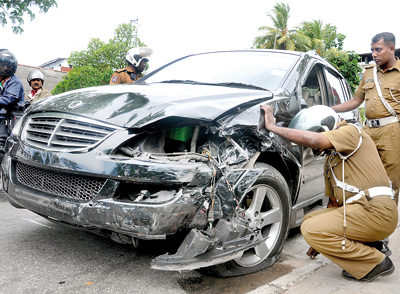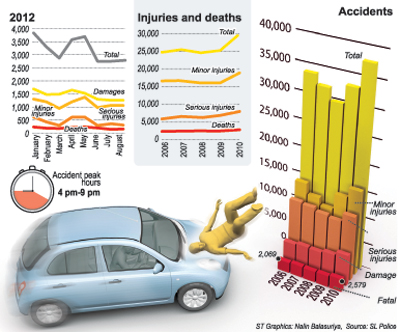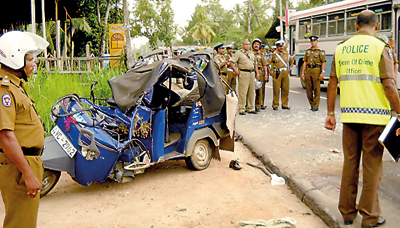News
Road killers: Will point system apply brakes?
The last few weeks have once again seen a spike in the number of accidents with one tragedy claiming the lives of a mother and daughter duo as they crossed the road in Ja Ela.
In this instance, according to police, reckless driving not by the driver but the conductor who did not have a driving licence in addition to being drunk, snuffed out the lives of Gangodage Shriyani (42) and her daughter, Imara Meepe (17) two weeks ago.
Police said the conductor and a few others had consumed liquor at Kudawela before the accident occurred in Ja Ela.
The conductor who is in remand custody will be produced in courts again next Tuesday.

A recent accident that occured close to the Gangaramaya temple in Colombo. Pic by Amila Gamage
In another instance of reckless driving a young motorcyclist lost his life in a collision with a lorry. Police said, Chanaka Susil (24) from Kadawatha collided with a lorry while trying to overtake it from the left side. He died on the spot due to head injuries sustained.
The lorry driver was arrested and produced in courts. Last week, in a case of public-spirited action that may have averted any impending accident, a bus carrying 147 passengers was apprehended by Induwara Police on receiving information that the driver was intermittently going off the road. It transpired that the driver was under the influence of alcohol.
He was charged Rs. 6,500 and jailed for three months while his driving licence was cancelled for one year.
National Hospital Director General Dr. Anil Jaasinghe said the hospital received more than 100 victims of accidents on a daily basis.
He said drunk-driving was not one of the major causes but reckless and selfish driving, the bad condition of roads and vehicles were leading causes of the accident cases.
Dr. Jaasinghe said an improvement in the public transport system and better roads could help in reducing the rate of road accidents. Cyclists, motorcyclists and pedestrians were most often the victims of accidents while bus and lorry drivers were the frequent offenders, Dr. Jaasinghe said, adding that the majority of both victims and offenders were between the ages of 20 – 40 and the most number of accidents occurred during evening rush-hour traffic between 4.p.m. and 9 p.m.
According to police statistics for this year, upto end August 25,578 accidents and 1,543 deaths with an average of 6.5 deaths a day were reported. The figures are the highest in seven years, excluding 2010.
In 2010 37,653 accidents 2,721 deaths were reported.The death toll related to road accidents went above 200, in January, April and May for this year with January recording the highest number of deaths, 235, police said.
Meanwhile the Dept. of Motor Traffic Commissioner General S. H. Harischandra said to curb the number of accidents a point system is to be introduced. He said this was being implemented with the collaboration of Police and Courts to discipline road users by imposing a driver improvement points system.
He said under the scheme once the offenders accept charges, the points would be added according to the nature of the offence committed.

Elaborating further Mr. Harischandra said police will be given a card reader where driving licences (smart cards) will be scanned and points added to it. The Registration of Motor Vehicles (RMV) will in turn be updated about the offence and the number of points.
When the points reach 18 the RMV will send a warning notice to the offender informing him/her of reaching the danger level and to be vigilant about not violating any further traffic rules and laws. If a person commits a serious offence the penalty would be 6 points while for a minor one it would be three points. The Commissioner General further explained if a person exceeded 24 points within a year his/her licence would be automatically cancelled.
Police would then send the driving licence to the RMV and the traffic offender would have to collect the license from the RMV after a period of suspension. If a person does not commit any offence for one year at a stretch then the gained points will be deducted by 6 and the points will be deducted annually.
Mr. Harischandra further said those who hold old driving licences (not smart cards), when they commit an offence the police will insert the driving licence number and the nature of the offence to a system that will automatically update the RMV.
Mr. Harischandra also said if the traffic offence was considered a hazard to the environment, such as pollution the offender would face 10 points.
He said it would be important to have an accurate software for the point-system to succeed and experts have come from South Africa to develop the software system for the RMV.
He said once the police and court had sufficient resources in place a pilot project would be implemented within Colombo city initially. A retired senior police officer, who was involved in traffic administration, said if the Driver Improvement Point System worked accidents could be reduced by 60 percent.
The point system implemented in many countries was introduced as a UN initiative, ‘Road Safety Decade’. Meanwhile, Police spokesman SSP Ajith Rohana said the police will set up CCTV cameras and Speed Meters in the suburban areas around Colombo, Kandy and other areas where the frequency of accidents is high.
Parliament passed the regulations regarding the mechanism of the driver improvement point system under the Motor Traffic Act in March, this year.
Taking a lull from the horn
New laws to curb noise pollution passed in Parliament
By Chandani Kirinde
Parliament on Wednesday approved new regulations under the Motor Traffic Act, to control the noise emanating from vehicular horns. These regulations were presented along with five other regulations including several orders made under the Special Levy Act and the Customs Ordinance, and hence, passed without much discussion.
Under the new regulations, no motor vehicle, whether assembled, manufactured, fabricated, adapted, etc., in Sri Lanka, or imported into the country, will be registered by the Registrar of Motor Vehicles (RMV) Commissioner General, unless they comply with the noise levels stipulated in the National Environmental (Vehicle Horns) Regulations of 2011.
The regulations make it mandatory for the owner or user of the motor vehicle to ensure that the person driving it acts in compliance with the laws on the use of horns.
They also empower the Commissioner General or an officer authorized by him, to ensure that motor vehicles are maintained in conditions that comply with the permissible noise levels.Commissioner General S.H. Harischandra said while the Department is the policymaking body, the implementation would be mainly carried out by the Traffic Police.
The restrictions on noise levels will not apply to ambulances, trains, fire brigade vehicles, police vehicles and vehicles used by the Armed Forces, as well as vehicles fitted with horns in times of an emergency or a disaster, to convey information to the general public.
The noise levels will be measured, from time to time, in terms of sound pressure levels, either using a sound level meter or any other measuring equipment recommended by the Central Environment Authority, Speaking during the debate on the regulations, Deputy Transport Minister Rohana Dissanyaka said the new regulations are introduced to safeguard the public from noise pollution.
Meanwhile, even though the National Environment (Noise Control) regulations were enacted way back in 1996, implementation of the laws has been slow.
The regulations designated ‘Silence Zones’ as specified areas of 100-metre radius from the boundary of a court house, hospital, public library, school, zoo, sacred area and areas set apart for recreation and environment purposes, but road signs that indicate these zones go largely ignored.
Follow @timesonlinelk
comments powered by Disqus
























